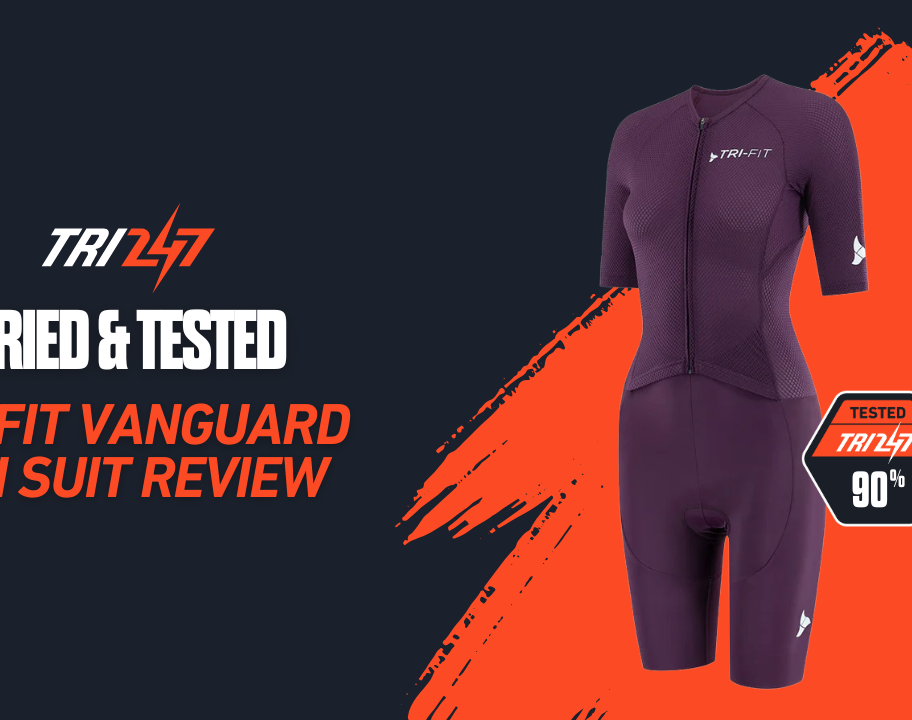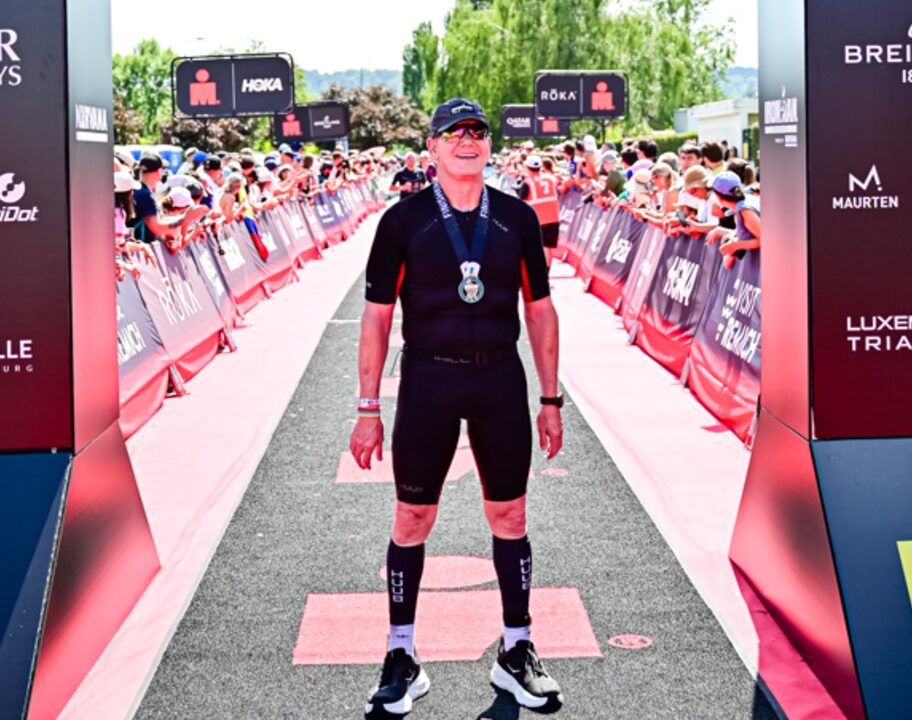Do you want more than the sound of your own thoughts while swimming? To help, we have compiled a guide to draw together the elements of swimming with your own personal sounds for company.
Whether that’s music or catching up on podcasts, here’s enough to get you started!
Lots of runners have been wiring up and listening to their playlists for years quite happily and, like it or loath it, music or podcasts can help you with your motivation as you tick off the miles in your training.
With the exception of Handel’s Water Music, typically, water and music have not mixed well. The transfer of sound into the ear or the delicate nature of iPod/Walkman (other brands are available) internal electronics tends to not like being submerged in water too much. However, more recent technological advances have made the potential to swim with sound a more feasible option.
How does it work?
There are two main effective sound delivery methods we looked at:
1. Water tight in-ear buds
- Wired in-ear buds to a waterproof MP3 player – these can be expensive (waterproofed iPod shuffle) or cumbersome and need to be attached to goggle straps or tucked into a swim cap.
- All-in-one player with wired or a neck band connection between left and right ear pieces. With the electronics built into the ear pieces in a neat band, but may lack features or be fiddly to use as the controls are by your ear and out of sight. This method requires the earpieces to (usually) use a special ear bud piece with a membrane that allows a tiny amount of air to be trapped in the ear canal to ensure the delivery of sound to the ear drum. Water is a poor conductor of sound so the special ear buds are essential to the units if you are to hear sound as intended underwater.
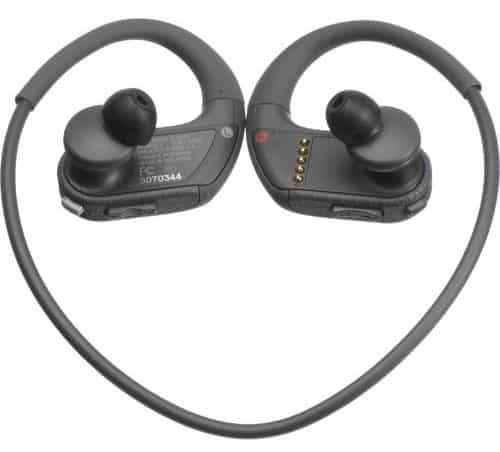
2. Bone conducting technology
Bone conducting technology is currently less common on the market and can be more expensive. These historically have been very polarising in popularity, but newer technology has made this method a viable alternative to the in-ear units and offers vastly improved playback of music over previous generations of the technology.
This method relies on the delivery of sound from a tiny transducer through the bone and into the ear canal. The units sit close to the ear, directly on the skin between the temple and cheek and not in the ear. Sound quality is vastly improved under water if you use an ear plug which ensures a consistent delivery of sound whilst still allowing ambient sounds to be heard.
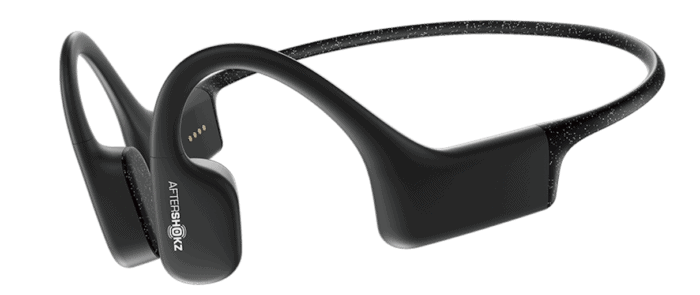
No Bluetooth
The main issue with Bluetooth underwater is that is doesn’t work with any level of reliability to make it a useful option. On dry land Bluetooth only has a limited working range on small devices of around 10m (33 feet) so in some pools you might go out of range of your phone and lose signal. This assumes that you don’t go underwater. As soon as your headphones get submerged (which unless you are doing a very gentle breast stoke this will be all the time), you will lose the signal. So rather than endure constant sound drop out built in memory offers the simplest solution and means constant sound no matter how much time you spend under water.
Streaming Services
All the systems we looked at had built-in memory which meant that there was no need for streaming music from Spotify or Apple Music etc in the water. Using a streaming service would mean a few issues such as having your phone close by on poolside and being able to get the music from the phone to your headphones. Whilst no problem on land, any point where part of the chain is underwater would stop the music, your phone would lose internet connection if taken underwater and/or your headphones lose Bluetooth connection to the phone.
Currently by far the simplest option is built in memory on the headphones and just leave the phone in your locker. Sometimes an existing idea just works!
How waterproof is waterproof?
Products are rated using a fairly standardised set of rules to govern what level of protection they have been tested to withstand before you buy them and take them swimming. The IP or Ingress Protection Ratings provide a good indicator of how safe a product is to stand up to various degrees of stress from water or solids such as dust. The IP number usually has one or two digits after to signify its rating. EG IP68 would be dust tight and withstand being submerged for a long period.
| First Number | Solids | Second Number | Water |
|---|---|---|---|
| 1 | Protected from a solid object greater in size than 50mm such as a hand | 1 | Protected against vertically falling water droplets, limited ingress allowed |
| 2 | Protected against a solid object greater than 12.5mm such as a finger | 2 | Protected against vertically falling water droplets with product at a 15 degree angle |
| 3 | Protected against a solid object greater than 2.5mm such as a screwdriver | 3 | Protected against water sprays at a 60 degree angle for 3 minutes with only limited ingress |
| 4 | Protected against a solid object greater than 1mm such as wire | 4 | Protected from water splashing at any angle with limited ingress |
| 5 | Dust Protected with limited ingress of dust permitted and will not interfere with the operation of the equipment for 2 to 8 hours | 5 | Protected from water jets at any angle with only limited ingress |
| 6 | Dust tight with no ingress of duster 2 to 8 hours | 6 | Protected from heavy water jets and heavy seas with no damaging ingress |
| 7 | Protected against temporary submersion, 30 minutes at 3 feet (1 meter) | ||
| 8 | Protected against the effects of permanent submersion in water up to 13 feet |
Why use headphones in the pool?
It’s not for everyone, but lots of swimmers moan about the monotony of longer swim training sessions and for some, following the black line at the bottom of the pool length after length can be tedious. Having a distraction can help with getting through a session. While not everyone wants music, you might be able to utilise the training time by catching up on your favourite podcast. You can also find training sessions to download to get the most out of your pool time.
Why not? Runners have been listening to music for years and now some cyclists like a bit of a tune mid ride but that is down to you… being able to hear ambient road noise is possibly a safer bet! Getting lost in music whilst cycling might be considered dangerous.
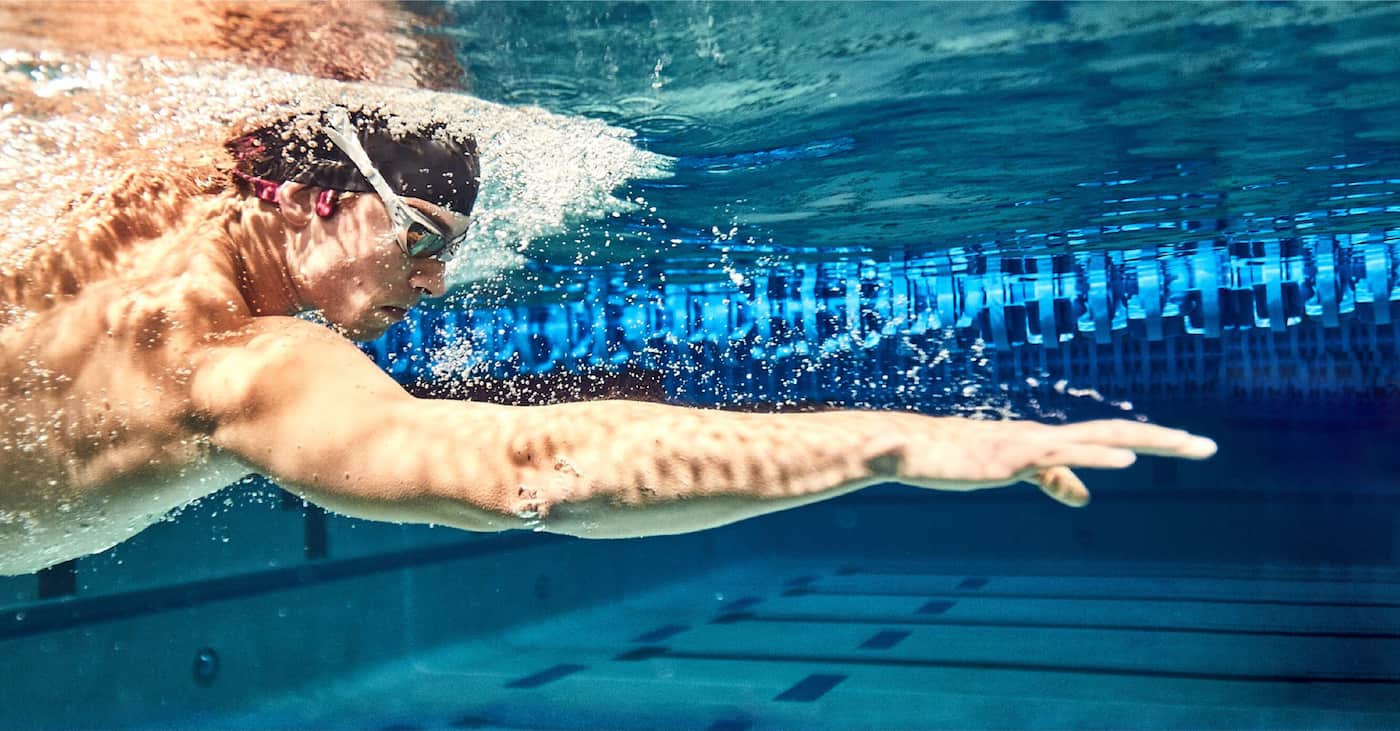
Top tips
- In some cases – depending on the headphones you are using – wearing a swim cap will greatly improve the comfort, fit and sound delivery of the units. Some in ear models are prone to falling out mid stroke or during a turn and rely on a cap to keep them in place and ensuring you don’t need to keep stopping to adjust the ear pieces.
- Get to know the functions before you swim will ensure you are not fumbling around in the pool trying to adjust volumes, track selection or playback mode. Most of the units we looked at had quite straight forward controls and were limited to basic functions which worked well enough.
- Check your playlist order when you download them from your computer; a little planning before makes things easier. Some of the units offer playback of folders of music, shuffled playback or just sequential. When you plug the units into your computer they will be treated like a drive so you can drop and drag tracks on and you can also order them in a kind of play list by numbering them to get the revised order of play you require. Not perfect, but simple enough if you need to.
- Wear ear plugs with bone conductor players for better sound in the water
- Depending on how often you train make sure you are charged up before swimming as you don’t want to power down mid swim
Swimming pool etiquette
- Be aware of your fellow swimmers around you just in case they are trying to talk to you.
- In-ear units can be isolating, as they cut out so much external noise and you might miss important safety announcements.
- Ensure you pay attention to your environment and if you are swimming in lanes then make sure you are being considerate to other swimmers.
What to consider when choosing your headphones?
Wireless, wired or all-in-one – Many of the units will work equally well on dry land so can double duty as your running music headphones.
The Finis Duo only work effectively in the water as they need to be held in place by your goggle strap so limit their appeal to some users.
Price – You will get what you pay for in terms of build quality, playback features and potentially durability.
Battery life – Unless you are swimming the Atlantic (or are Ross Edgley!), most of the units available offer ample playback times to cover even the longest training session, 7-12 hours is typical.
Fit/Comfort – All the units we looked at were offered with different sized ear buds (where needed) so comfort can be tweaked. Often a water specific bud will be included to ensure best fit and keep the water out. If you do not favour in the ear headphones then the bone conducting units will offer a great alternative.
Other use – Will you want to use them on dry land too? Units with short corded earpieces etc will not be ideal for general use or without a swim cap so it’s worth checking the chord is long enough to reach a pocket or arm pouch.
Weight – Weight won’t matter too much in the water but heavier units might be less comfortable if you are using them for running too.
Ease of use – Fiddly buttons, awkward loading of music and getting them in place before swimming can be an issue. Features including folders, playback, shuffle, water modes, external. All the units we tested used a simple drop and drag system to load up music, creating a folder to sync headphone music was simple enough. Be aware that some units only playback certain types of music files such as MP3, iTunes for example allows you to convert tracks to MP3 very easily so this was not really anything to worry about.
Care advice
- Keep your headphones away from your kit in a pouch or small case to protect them from wear-and-tear to cables
- Rinse off your headphones straight after swimming to remove chlorine or salt water which will damage your equipment over time
- Keep them as dry as possible when not in the water
- Take time to ensure any removable parts like the ear buds are clean and dry when not in use
- Ensure any charging connectors are regularly cleaned to ensure the best contact with charging cable
- Make sure the connection and headphones are dry before charging
Pros and Cons
- As with many race events you will not be allowed to take part if you have in-ear headphones as they are considered a hazard and could prevent you hearing essential safety warnings, you’ll need to check first or you could be disqualified. There are events where bone conducting headphones are allowed but again, check first that the race organisers don’t just ban all music playback
- Bluetooth headphones don’t work effectively underwater because the signal doesn’t transmit the same way underwater as in the air. This makes wireless Bluetooth headphones useless for swimming.
- In a public environment like a swimming pool it might be safer to be able to hear your surrounding environment
- Any units that require to be attached to goggles straps or tucked under a swim cap will not be ideal on dry land for running for example
- Wired headphones can get tangled whilst swimming and extra care is needed
- Music is definitely a motivator which can help you swim faster or longer
- Bone conducting units keep your ear canal free so you are aware of external noise/voices/warnings etc. Great for cycling and running too
AfterShokz Xtrainerz Open-Ear MP3 Swimming Bone Conduction Headphones £139
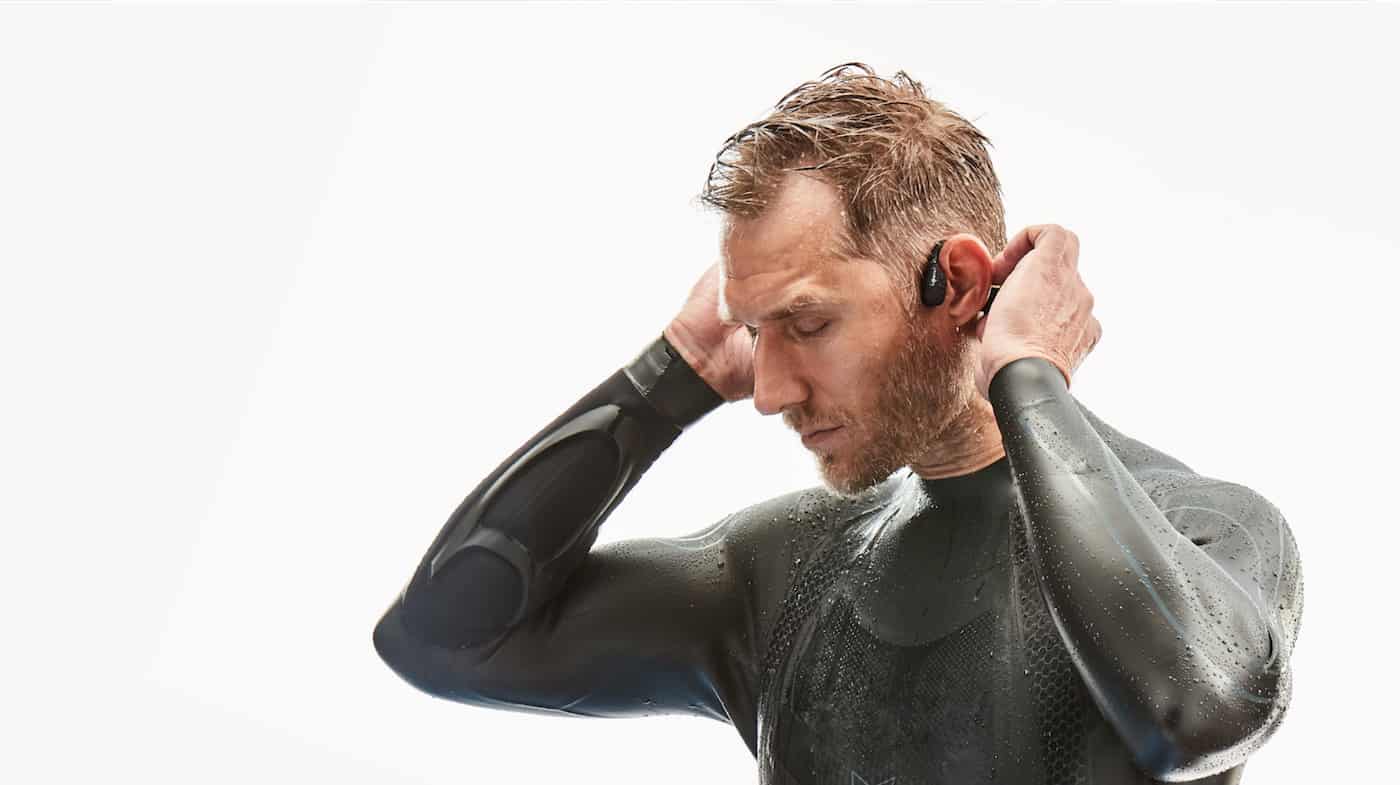
- Designed for Swimming
- IP68 Waterproof
- Compatible with swim goggle, cap, and earplugs
- Plenty of bass and volume underwater with water equalisation
- 4GB Memory supports MP3, WMA, AAC, WAV,AND FLAC audio formats
- Eliminate painful experiences caused by in-ear headphones
- Fit securely even with intensive body movement
- 8 hours playback time, workout without your phone
If you’re new to bone conducting headphone technology we have been trying out the new AfterShokz Xtrainerz as part of this article and in a group test coming soon.
These units differ from traditional headphones in that they sit outside your ear canal, just in front in fact and utilise the little bones that form part of your ear. Sound is conducted into your inner ear via a tiny transducer where a traditional ear bud would be and so you still get to hear external noise such as traffic and warning sounds. It’s far less isolating and a great safety feature!
Getting Started
Out of the box our unit came with a nice soft carry case, USB charger, a swim cap and a pair of ear plugs.
Plugging in was easy and dragging music over from iTunes was simple. Creating a folder on your computer where you can arrange tracks in a kind of order and I did this by amending each track name with a number pre-fix. A little more manual than using iTunes etc alone but is was simple and in no time music was loaded up and it was ready to get in the water.
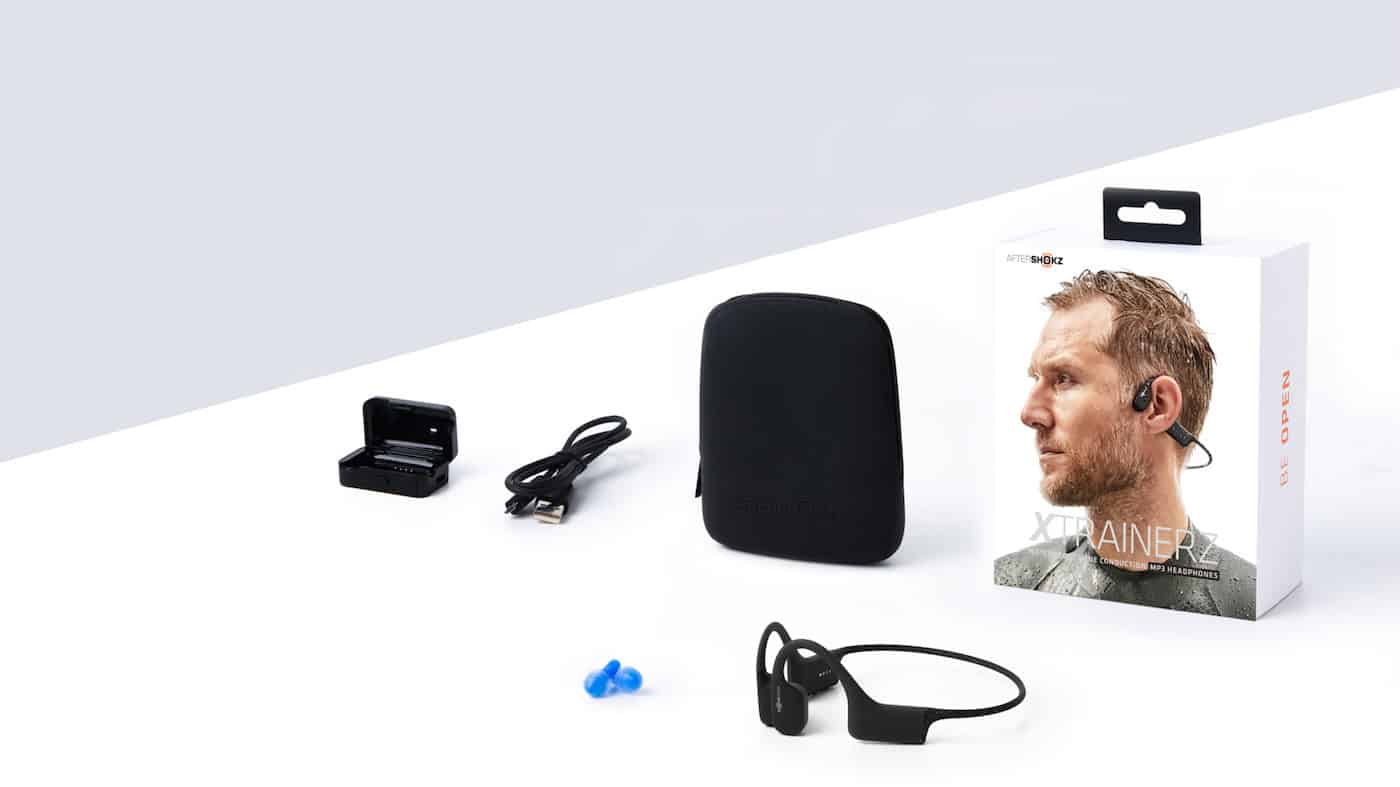
The one size fits all back/neck strap was nice and snug and the neck band fits over the top of your ears comfortably. The band was well built with a pleasing rubberised finish and the ear loop was narrow enough to make it comfortable to wear glasses as well. This is handy as the headphones can be used out of water too.
Functions on the headphones are straight forward and are second nature very quickly. An on/off button, volume/skip and a mode button for swim or normal playback.
4GB of internal storage is a big chunk and enough for the majority, that translates into 1,000+ tracks which can be in various formats including MWA, AAC, MP3, MAV, and FLAC. The claimed 8 hours of battery life seems a reasonable statistic too as it’s not run out on test yet.
What are they like to use?
A great feature of the new headphones is the sound quality out of water. Yes they are designed to give great underwater sound but they also work really well on dry land. It seems like a lot of cyclists are listening to music out on the road these days which does carry safety issues, but with the Xtrainerz you can still hear external sounds which makes things far safer. The same goes for running; the safety aspect is a huge benefit, being aware of your surrounding environment cannot be understated.
In the pool the Aftershokz were tested without a swim cap at first and things were fine. They stayed in place quite happily even on turns where many ear phones get dragged out of the ear the Xtrainerz are very slim and sit flush to the face admirably. The swim mode seemed to cut out some of the boom of bass underwater and when you put in the ear plugs or just put your fingers in your ears the sound really comes alive. Adding a swim cap and even the fastest turn and push off did not unseat the headphones.
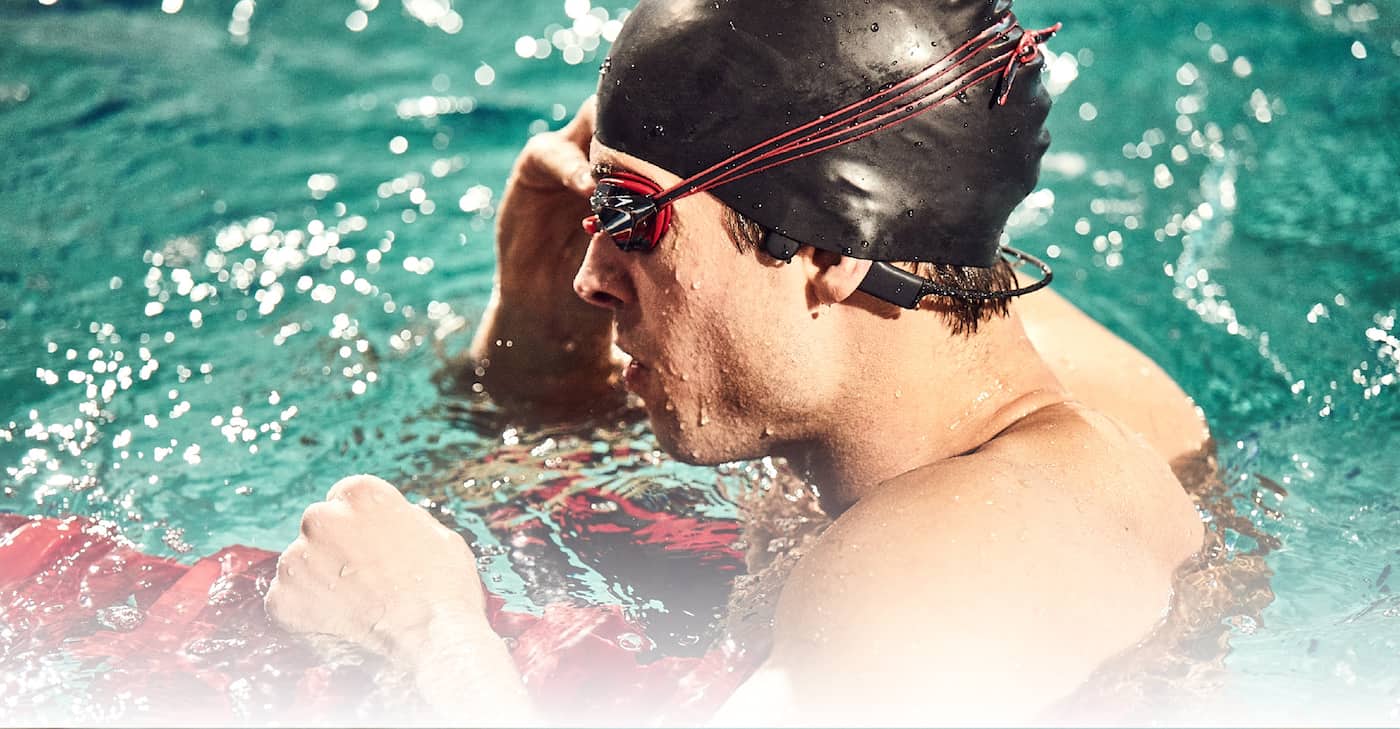
As with any underwater headphones sound quality is not going to be on a par with audiophile quality. You have to accept that as water is very good at muffling sound, so with any headphones we looked at it’s a best case scenario.
Given that you accept the slight compromise in sound quality it’s hard to criticise the latest Aftershokz offering. I think out of the water some of the in-ear units we looked at had a slight edge in sound depth but at a pretty hefty price of cutting you off from your environment.
In terms of everyday use there will be times where you do want the isolation of the in-ear buds, but that is not the point of the Aftershokz – they offer a solution to a number of issues and solve them well. The Aftershokz offer an extra way to listen to music in an environment where you would not normally expect great sound and they do it very well, they are not a one trick pony. You wouldn’t expect to use your AirPods in the pool, likewise your Aftershokz Xtrainerz don’t stream Spotify. They do different jobs.

If you are looking for Bluetooth connectivity, you are missing much of the point. Yes, you can’t stream music to them but there’s enough storage to not have any issues about running out of music! It’s really hard to stream music underwater and this is where these headphones make perfect sense and as a happy bonus they work very well out of the pool and there will be plenty of times where you will end up picking these up and going for a run and ditching the phone. I am sure that Bluetooth would make these without doubt some of the best all round headphones, but I quite like the grab-and-go nature, no fuss, just turn them on and go swimming!
In conclusion, the Aftershokz Xtrainerz offer great underwater sound and are easy to operate, they work very well on dry land too and have the added benefit of allowing you to hear external sounds far better which is an essential safety feature. They are a bit more expensive than some other headphones but totally worth the extra spend. As an everyday standalone music player they work great. They are highly recommended.
You can find out more on their official website here


 Triathlon’s mid-season report card: Tim Don on who’s raising the bar this triathlon race season
Triathlon’s mid-season report card: Tim Don on who’s raising the bar this triathlon race season